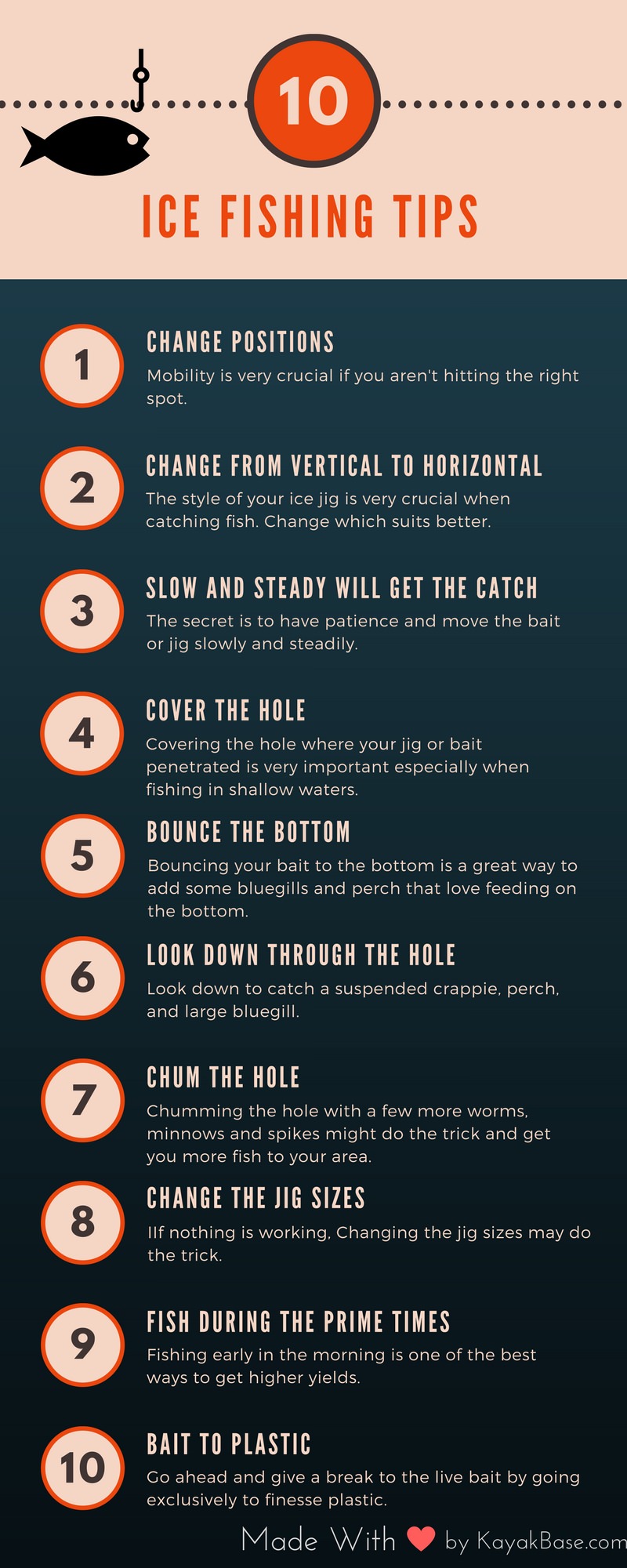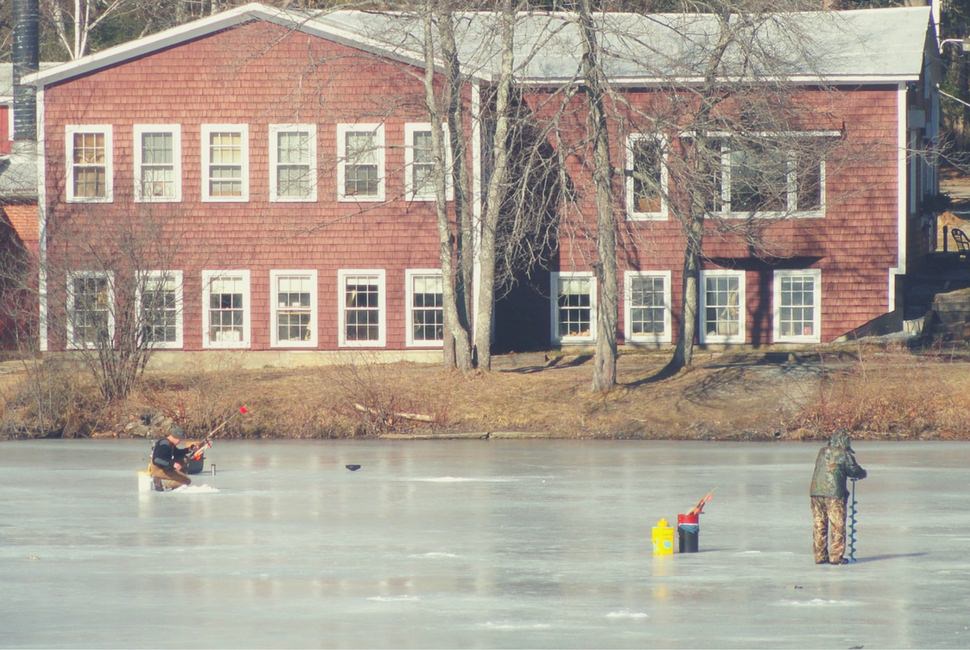Last Updated on April 6, 2022 by Afsar
Are you looking for ice fishing tips online? It is safe to assume that you are trying to be the best when it comes to ice fishing. When winter’s ice seals the waters, the fun of catching fish does not just stop there. Ice fishers will tell you the change of approach when fishing gives them some catch despite the ice cover. Ice fishing has come a long way in recent years with advancements in tactics and tackles.
This article aims at giving ice fishers tips on how they can easily catch fish through the ice. Almost everyone can catch some panfish on the ice. However, when one fails to catch fish, the blame is usually on the fish which should not be the case. The article will educate on the tips you must learn whether you’re an expert or just a novice ice fisherman.
Table of Contents

Top 10 Best Ice Fishing Tips
1. Change positions
No matter the place of fishing, mobility is very crucial when you can’t catch any fish. How long have you been in the same spot without catching fish? If you’re not getting any bites, then try to change positions. Warm floating suits and portable huts that are set up in a minute have it quite easier to try new spots. Handheld GPS units, fish finders, lightweight ice augers, snowmobiles, and ATVs are now easy to carry with advancements in technology.
2. Change from Vertical to Horizontal
The style of your ice jig is very crucial when catching fish. I bet you’re used to the tear-dropped jig shape that hangs vertically in the water. Tear-dropped jig, Beetle, and Jammin Jigs all hang vertically in the water. When you don’t seem to get any vertical bites, then it is time to switch to a jig that hangs horizontally in the water. The style of the jig is as important as the color of the jig. Perch and crappies bite better on horizontal jigs. Just make sure you head out fishing with a wide variety of both horizontal and vertical jigs.
3. Slow and steady will get the catch
It is worth noting that almost all fish try to spend as little energy as they can during the winter season. They are less aggressive and will not rush to hunt down prey as they normally do during the summer season. Moving your jig or bait too fast will not yield you any results. Most fish will let it go to save some energy. This is a major problem faced by almost all novice ice fishers. The secret is to have patience and move the bait or jig slowly and steadily.
4. Cover the hole
Covering the hole where your jig or bait penetrated is very important especially when fishing in shallow waters. Most fish will tend to avoid areas where light seems to penetrate. Keep some ice shavings on the ice to prevent light penetration. However, light can also work to your advantage if trying to catch crappie. Light attracts planktons which in turn attract crappies to your jigs. It is important to make sure you understand what you’re catching and use the light to your advantage or cover the hole instead.
5. Bounce the bottom
Bouncing your bait to the bottom is a great way to add some bluegills and perch that love feeding on the bottom. The perch and bluegills predominantly feed some few inches of the bottom and will not come to baits placed some distance above the water surface. When the jig bounces off the bottom, the small sound and cloud created attract fish from a distance. A spring bobber will come in handy. The jig barely rests on the bottom with most of its weight on the spring bobber. When fish bites, it rises with the fish bait/jig causing the spring bobber to rise.
6. Look down through the hole
Looking down the hole and watching how fish take the bait is not only a great experience but a way of learning how fish responds to various jigging and baits. It is one of the best ways to catch suspended crappie, perch, and large bluegill. Bluegills have been known to hover around the bait, inhale it and then quickly spit it out. This happens quickly without moving a line. Your floater or spring bobber will not even detect it. Looking down the hole and setting the hook when you see a bite is the only way to catch these kinds of fish sometimes.
7. Chum the hole
Chumming the hole with a few more worms, minnows and spikes might do the trick and get you more fish to your area. Even though most fish will not want to exert a lot of energy in icy waters, they will be attracted to another fish feeding. Grinding some minnows will let them go crazy attracting other fish to the spot where your bait of jig is resting. This gets the fish feeding aggressively and falling to your tricks by getting a bite.
8. Change the jig sizes
Most people tend to change the color of the jig when they do not have any bites. However, changing the size of the jig can work for you and give you more bites. This tip works both ways for small and large jigs. This is why you need to have as many jigs of different sizes as you can when ice fishing. Changing from the Teardrop size six to size ten will result in catching more but larger bluegills.
9. Fish during the prime times
Fishing early in the morning is one of the best ways to get higher yields. Most fish species are at their peak active early in the morning and late in the afternoon. Take advantage of this by fishing very early in the morning or late in the afternoon. This gives you a whole free time in the evening to spend more time with your family if they didn’t accompany for fishing already.
10. Bait to plastic
Go ahead and give a break to the live bait by going exclusively to finesse plastic. The plastic lures are an excellent way to attract fish that seems to be tired of the live bait. These plastic jigs work well in clear waters. They shake and quiver with the slightest of movement of the rod. This seems a very unlikely tip but works wonders when fish seem to avoid your live bait.
Conclusion
The next time you find yourself blaming the fish for not getting any bites, think again. You must be smart and know how to apply the tips above to get the fish biting. You can also learn about hypothermia just in case of accidents. Remember someone can die after 20 minutes of being soaked in ice water. Always remember these ice fishing tips when you are preparing for your next ice fishing endeavor.
Good Read:
- 10 Best Ice Fishing Shelter
- Best Ice Fishing Rods
- Best ice augers
- Insulated Lunch Bags
- Ice fishing sleds
- Best ice flasher review

Afsar is an avid kayak blogger born near the coast. He has a passion for kayaking and started as a child. He has paddled in various conditions and locations and promotes responsible kayaking. Afsar’s blog is widely read, and they are a respected voice in the kayaking community, offering valuable content on kayaking trips, gear, tips, and tricks. Afsar collaborates with other bloggers and brands and continues to inspire others through their writing and social media.

